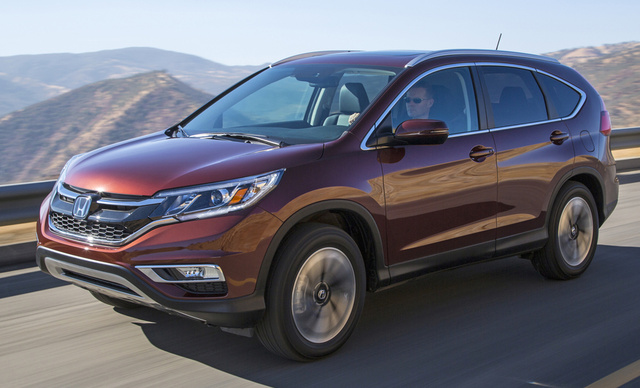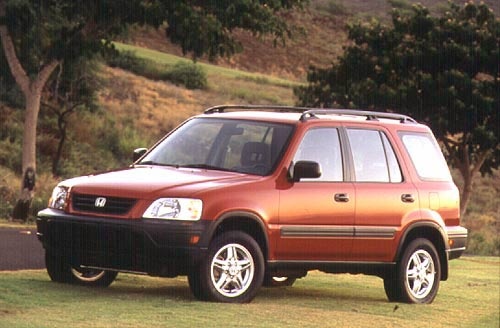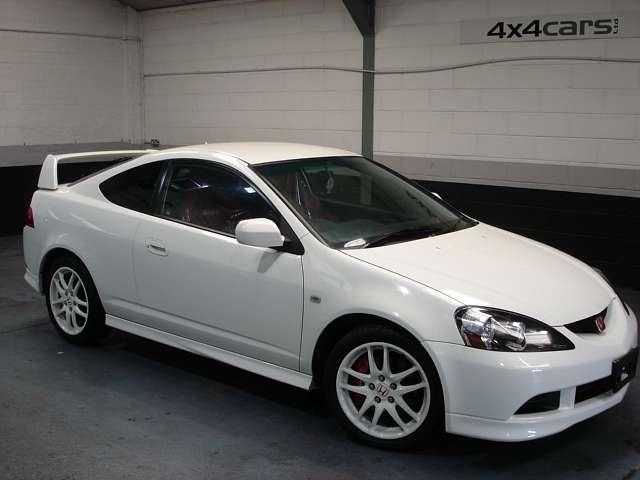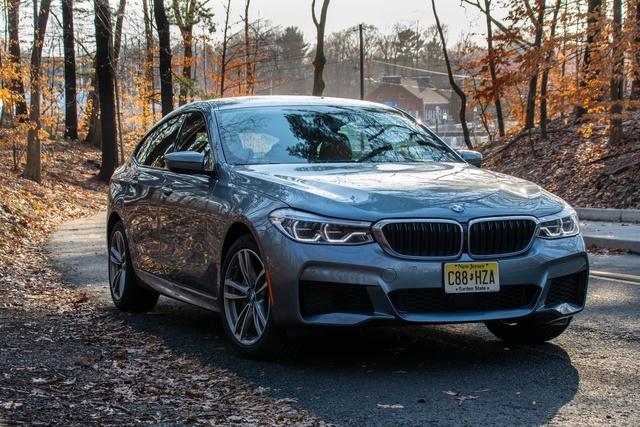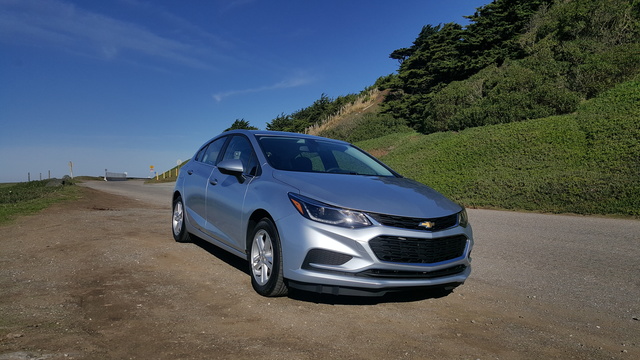One of the earliest small crossover SUVs, the Honda CR-V was the Japanese automaker’s response to the Toyota RAV4, and the two are still close rivals today. Toyota had been working on the RAV4 for almost half a decade before it debuted in Japan in 1994, but Honda had also been developing similar ideas for years. The CR-V (“Compact Runabout Vehicle”) is a scaled-up version of the concepts first seen in Honda’s tall, unconventional, and popular 1980s Civic station wagon, a mix of proto-crossover and tiny minivan.
After debuting in Japan in late 1995, about 18 months after the RAV4, the CR-V came to North America just months later as a 1997 model. The term “crossover” hadn’t even made its way into vehicular vernacular back then, and the CR-V was usually referred to as a small SUV. But Honda and Toyota had ditched the traditional body-on-frame layout of most SUVs in favour of unibody construction and car-based mechanical pieces. The original CR-V rode beefed-up versions of the same mechanical pieces as the Civic.
This decision offered more efficient use of interior space and, perhaps most importantly, delivered more car-like ride and handling characteristics (as well as more car-like mpg) from behind the steering wheel. Ever since, the CR-V has been recognized for its often class-leading blend of comfort, versatile functionality, reliability, and value. Compact crossovers like it have proven to be ideal for small families, daily commuters, and weekend adventurers who need a relatively efficient and affordable vehicle with much more space and utility than a sedan. As a result, crossovers have since conquered the new vehicle market.
Within Honda’s lineup, the five-passenger compact CR-V slots above the smaller HR-V but below the larger midsize two-row Passport and three-row Pilot. Output has varied over the years, but all CR-Vs have featured four-cylinder engines and a choice of front-wheel-drive (FWD) or all-wheel-drive (AWD) capability. In 2020, Honda added a CR-V Hybrid for the first time. Initially, its North American availability was limited the U.S. as it was available only with FWD. Once an AWD version was developed as part of the 2023 redesign, the CR-V Hybrid hit the Canadian market.
This newest CR-V also gets upgrades to its technology, styling, and comfort features but comes with the same safety tech we’ve known and loved in previous model years. Those standard features include lane-keeping assist, forward collision warning, road-departure mitigation, blind-spot monitoring, rear cross-traffic alerts, and adaptive cruise control. Like its predecessors, it’s regularly won “Top Safety Pick” awards from the Insurance Institute for Highway Safety (IIHS).
There are many flavours of compact crossover nowadays, and CR-V and RAV4 shoppers should also consider alternatives like the Mazda CX-5, Nissan Rogue, Kia Sportage, Hyundai Tucson, Subaru Forester, or Chevrolet Equinox. The CR-V is known for reliability, safety, and economy. It offers plenty of features, particularly on the top trims, but isn’t the most spirited driver or the most distinctive in terms of style.
Not all of these alternatives existed 10 or 20 years ago, so we’ve assembled this guide to tell you more about each CR-V generation, with some recommendations about what to watch out for and what to pay.
Honda CR-V: Cost, Reliability, and the Best Years to Buy
- Frequently Asked Questions
- Honda CR-V Pros and Cons
- Honda CR-V Generations
- Sixth Generation (2023-Present)
- Fifth Generation (2017-2022)
- 4th Generation (2012-2016)
- Third Generation (2007-2011)
- Second Generation (2002-2006)
- First Generation (1997-2001)
Frequently Asked Questions
Which Honda CR-V years are the best?
Almost all CR-Vs have good reliability records, but models built from 2013 to 2016, and those built from 2020 to the present have the best records for which good data exists—and the newest cars are of course also still covered by Honda’s warranty.. They consistently get above-average or “Great” ratings from outlets like J.D. Power and Consumer Reports, though 2015 models generate a fair number of gripes on CarComplaints.com. It’s hard to go too far wrong on a CR-V, though, and even very old first-generation models are generally reliable.
What are the worst Honda CR-V years?
CR-Vs built from 2017 to 2019 seem to have taken a hit on quality and reliability, as these years have generated more negative feedback than most others across the board. The issues seem to centre on electrical and engine problems, and issues with the HVAC systems. 2017 CR-Vs seem to be the worst of all, with the highest number of issues on crowd-sourced sites like CarComplaints. Among older models, 2007 to 2009 models are also less reliable than average. It’s important to inspect carefully, though, because the CR-V’s famous reliability can sometimes lead to neglected maintenance.
Is a used Honda CR-V a good deal?
Yes. CR-Vs cost a little more than other compact crossover SUVs, but they have one of the best reliability records in the class and are generally long-lived, low-maintenance rides. Over time, the quality and fuel economy do mean some cost savings, which helps offset their higher resale values.
Honda CR-V Pros and Cons
Pros:
- A solid value in all generations
- Stellar reliability record
- Roomy cabin and cargo area
Cons:
- Not all that engaging to drive
- Base models are very basic
- More expensive used than some rivals
Honda CR-V Generations
Sixth Generation (2023-Present)
For 2023, Honda comprehensively redesigned the CR-V into a more handsome shape and put an emphasis on hybrid power. While the gas-powered, 190-horsepower 1.5-litre four-cylinder turbo engine remains from the fifth-generation model, Honda made the specs for the CR-V’s top trims hybrid-only. Their updated drivetrain, capable of burning as little as 6.4 litres per 100 kilometres combined, makes 204 system horsepower and 247 pound-feet of torque, and these models come with more features than the rest of the CR-V line-up.
In addition to a more handsome wrapper that makes it more distinctive, the sixth-gen CR-V’s interior is also bigger. It has 1,042 millimetres of rear legroom, which is only marginally more than the previous model, but much more than rivals like the RAV4 or Mazda CX-5. There’s also marginally more cargo room, up to 1,113 litres (39.3 cubic feet) behind the rear seats and 2,166 litres (76.5 cubic feet) with them folded. Although the hybrid powertrain cuts into these figures slightly, both versions are right at the top of their class.
Honda also still piles on the safety features, with standard adaptive cruise control and some newly standard gear like traffic jam assist and traffic sign recognition. As a result, the new CR-V earned a “Top Safety Pick+” designation from IIHS in 2023, and “Top Safety Pick” in 2024. The infotainment system is on the basic side, but top trims get wireless Apple CarPlay and Android Auto, and the CR-V remains an easy vehicle to learn to operate.
These CR-Vs are still very new cars and they’re only just hitting used lots. On top of that, pricing for new CR-Vs in Canada—despite being assembled at Honda of Canada Mfg. in Alliston, Ontario—is among the highest in the compact SUV segment. Expect to pay a minimum of $30,000 for a gas-powered low-trim model and probably closer to $36,000 on average. Hybrids will cost even more, with prices starting at $40,000. This does represent savings of roughly $10,000 versus the msrp of buying a hybrid new, so these used examples are a better deal than gas-only CR-Vs.
Fifth Generation (2017-2022)
Honda's fifth iteration of the popular CR-V compact crossover debuted for the 2017 model year. Highlights included bold (if polarizing) styling that made its predecessor look drab by comparison, increased dimensions resulting in extra rear legroom and cargo space, and chassis revisions designed to improve ride, handling, and braking performance. In Canada, AWD capability was optional on the base LX trim and standard on the rest: EX (or Sport in the latter years), EX-L, Touring, and later the Black Edition. This iteration of the CR-V also introduced a ‘hands-free’ power tailgate.
Canadian CR-V models came standard with the new turbocharged 1.5-litre four-cylinder providing 190 horsepower and an estimated 7.2 L/100 km with AWD in highway driving. Other enhancements arriving with the 2017 Honda CR-V were the broader availability of the Honda Sensing suite of safety technologies and a simple physical volume knob to improve the usability of the touchscreen audio system.
There were no notable changes for 2018 or 2019, but 2020 brought a major refresh. Honda Sensing became standard on all models. (It was standard on all AWD models prior to 2020, so most used CR-Vs in Canada will have it.) There were also new colours to choose from.
2017 to 2019 CR-Vs tend to have more problems than other years, but they still make decent used vehicles. CR-Vs of this era should sell for less than $30,000 now, but earlier models will go for less, roughly $20,000 to $22,000 for a good one. 2020 and newer models sell for more, but even a top 2022 Touring model can be had for $35,000.
Fourth Generation (2012-2016)
Honda's CR-V greeted the 2012 model year with yet another redesign. Though a hair smaller than its predecessor on the outside, the 2012 CR-V provided more interior space for cargo and up to five passengers. Power came from the same 2.4-litre four-cylinder engine as in the previous generation, mated to a five-speed automatic transmission, but horsepower was up to 185, and estimated highway fuel economy dropped below 8 L/100 km with AWD.
Buyers could select from LX, EX, EX-L, and Touring trim levels, with a navigation system equipped on the latter. Also among the 2012 Honda CR-V's many changes was a reconfigured flat-folding rear seat that replaced the fold-and-tumble design in earlier CR-Vs.
In typical Honda fashion, the CR-V was left mostly unchanged for a couple of years and then revised mid-way through its life in 2015. The engine remained the same size but was re-engineered for cleaner emissions, and the conventional automatic transmission gave way to a continuously variable transmission (CVT) for better fuel economy, resulting in a 1 to 2 L/100 km drop in most measurements.
These fourth-generation models are fairly basic apart from the 2015-2016 Touring, and that model is worth paying extra for because of its advanced safety features such as adaptive cruise control, lane keeping assist, lane departure warning, and automatic emergency braking. All have a top-notch reliability record even if they aren’t very exciting to drive, but prices vary considerably depending on odometer reading and condition. It’s harder to find these models with under 100,000 kilometres than the newer fifth-gen versions, and you can expect to pay $20,000 to $22,000 for really nice ones.
They’re long lived though, and examples with 100,000 to 150,000 kilometres on the clock are more common and available for anywhere from $13,000 to $17,000. Any of these years make a solid, reliable long-term choice.
Third Generation (2007-2011)
For 2007, the Honda CR-V was redesigned again, this time rolling away with a more curvaceous exterior. While it may have appeared to be smaller, this version of the five-passenger CR-V provided a bit more cargo space, and under the skin, it re-used some of the structural and mechanical pieces of its second-gen predecessor.
What had been a tradition for all CR-Vs—a side-opening tailgate with an exterior-mounted spare tire—was replaced with a more traditional top-hinged liftgate and a spare mounted under the cargo floor. The removable picnic table didn't make the cut this time around, nor did the five-speed manual gearbox.
Instead, Honda installed a five-speed automatic as the exclusive transmission for this generation of CR-V. Under the hood was a 166-horsepower version of the previous 2.4-litre four-cylinder engine, with fuel economy now reaching an estimated 9.3 litres per 100 kilometres on the highway with AWD. Trim choices for 2007 included the Honda CR-V LX, EX, and top-of-the-line EX-L—optionally available with navigation in the EX-L Navi trim—in varying degrees of plushness. These trim designations mean a little less now than they did then, as this was before the era when the top trims got sophisticated driver-assist gear, and some of the luxury features seem basic today, like Bluetooth connectivity or a USB port (newly available on the EX-L in 2010).
For the most part, Honda left the CR-V unchanged until 2010, when designers once again performed a bit of nipping and tucking. In addition to visual updates, the 2010 Honda CR-V featured a retuned 2.4-litre engine that generated 180 horsepower.
2007 and 2008 CR-Vs have a less stellar reliability record than earlier and later models, but all CR-Vs of this era are reasonably reliable. The complaints tend to centre on interior quality and features, not mechanical maladies. Clean, low-kilometre examples of this CR-V are rare now, but you can still find some examples with fewer than 150,000 kilometres for $11,000 to $15,000. If your budget won’t fit that, models with up to 200,000 kilometres can be had for even less. They’re reliable and cheap to run, and they still look fairly modern thanks to the CR-V’s evolutionary styling.
Second Generation (2002-2006)
Five years after the CR-V's initial introduction, an entirely new second-generation Honda CR-V arrived for the 2002 model year. Larger and sporting what was arguably more conventional styling, the five-passenger 2002 CR-V included bonus safety features like four-wheel antilock disc brakes and front-row side-impact airbags, though some of these features were still reserved for higher trims. It also carried on the CR-V tradition with its vertical taillights and rear integrated picnic table.
Honda scrapped the first generation's less-powerful engine to make room for a 160-horsepower 2.4-litre four-cylinder with Honda's i-VTEC (intelligent Variable Valve Timing and Lift Electronic Control) technology, which Natural Resources Canada rated as low as 9.5 L/100 km on the highway. Shoppers considering the 2002 CR-V received standard AWD (which Honda referred to as Real Time 4WD) capability, a five-speed manual or four-speed automatic transmission, and LX or EX trim levels. Manual CR-Vs are nicer to drive, but much rarer than automatics.
This version of the CR-V underwent few significant changes over the next couple of years, but 2005 ushered in a mild refresh. More importantly, the list of standard safety features grew, including the anti-lock brakes (which many competitors had already added). A five-speed automatic transmission replaced the original four-speed. There were no notable changes for 2006, the last year of production for the second-generation CR-V.
Second-generation CR-Vs have considerably more passenger space than the original, particularly in the back seat, which grew by more than 7.5 centimetres in terms of available legroom. They also look and feel a little more luxurious, though they’re basic by today’s standards. Like the original, they have a rock-solid repair record and make for very good low-cost transportation.
Canadian weather has done a number on this generation of CR-V, which is rare across the country. The ones that have survived tend to have high odometer readings. Clean examples start at around $5,000 and go up to about $10,000, but it’s probably not worth paying quite that much for one this old as the fourth-gen models aren’t much pricier.
First Generation (1997-2001)
Honda’s first home-grown SUV, the first-generation CR-V, was revealed in Japan in late 1995. The vehicle made its North American debut just a few months later at the 1996 Chicago Auto Show and hit the market as a 1997 model. Closely based on the Civic, the CR-V essentially expanded on the formula of the 1980s-era Civic “tall wagon,” which was Honda’s first vehicle to offer all-wheel drive and which largely predicted the shape and scope of the CR-V.
The CR-V came only with a 2.0-litre four-cylinder engine, making 126 horsepower and 133 pound-feet of torque. At first, a four-speed automatic was the only transmission, but Honda added a five-speed manual option in 1998. Automatics were more popular, but a fair number of buyers chose the manual for slightly better fuel economy (about 11 L/100 km combined, which isn’t great fuel efficiency by today’s standards).
That car-based unibody platform delivered a much more sophisticated driving experience than SUV customers were used to, while those in the driver seat and passenger seats alike could enjoy the elevated SUV view, especially from those front seats.
The global CR-V got an update in 1999, but the vehicle continued on in its previous form in North America.
Although most first-generation CR-Vs in Canada have succumbed to our climate, the few that remain and the used inventory south of the border are now (perhaps surprisingly) starting to attract attention from collectors. Given the popularity of Japanese imports from the 1990s, a few right-hand-drive Japanese versions can be found in the U.S. if you’re interested in such a specialized machine. Canadian first-gen CR-Vs now generally have 250,000 kilometres on the odometer or more and sell for less than $5,000. It’s still possible to find really good, cheap transportation with these, even though they’re now pushing three decades old. They’re long-lived, hard-wearing, and cheap to buy and run.

